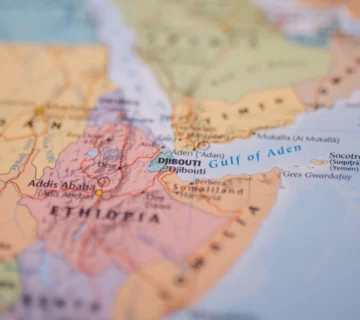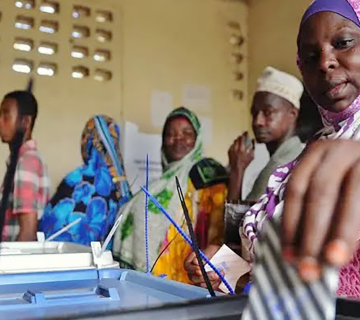Following the consistent dominance of Kenya’s sportsmen and women in world athletics, Kenya is now poised to exploit its strength in sports diplomacy (SD). This was displayed in New York on October 7, 2019, at the recent official launch of Kenya’s bid for the United Nations Security Council (UNSC) non-permanent seat. Top Kenyan athletes were strategically included to be part of the high-level delegation of diplomats. In putting these sport icons at the forefront of its campaign, Kenya seeks to convey its image through their achievements and show the “contribution of Kenyan people to the world”. Imperatively, it appears that Kenya is keen to seize its strength in sports as a tool of foreign policy and to synergize its efforts for winning the UNSC seat. In order to strengthen SD as a tool of foreign policy, Kenya should organize its practice of SD in three ways: as a status symbol, identity maker, and interest promoter.
For close to three decades, Kenya has been on the global limelight for its richness in athletics. Athletes such as Paul Tergat, Tegla Loroup, Eliud Kipchoge, and Brigid Kosgei have demonstrated their eminence in world athletics. Together with many other sportsmen and women, these individuals have represented Kenya at various levels in international sporting competitions thus putting Kenya at a favorable position within the global stage of sports.
Defining Sports Diplomacy
There is not a singular stark definition of the term sports diplomacy. In practice, SD is seen as a subunit of cultural or public diplomacy. However, categorizing sport diplomacy as either public and/or cultural diplomacy runs the risk of undermining its distinctiveness and effectual strength in furthering foreign relations. From a political standpoint, sports diplomacy can be defined as the art of using sport as a platform for passing structured or targeted communication aimed at resolving international problems and enhancing relations among states. Accordingly, a recent article published by GLOBSEC describes sports as a ‘’social phenomenon and universal language’’ that can transcend strained diplomatic relationships and offer a pathway for mutual understanding. As a form of diplomacy, it goes beyond the mere practice of holding sports events in a country to the strategic use of sports and sportspersons to pass specific messages on issues of national interests at an international level.
Murray Stuart, in his article The Two Halves of Sports-Diplomacy, argues that through sports diplomacy, states aim to establish strong links with the public abroad in order to push forward its foreign policy agenda and achieve specific objectives. Interestingly, this kind of diplomacy capitalizes on shared emotions and passion for sports to appeal to individual states while pushing into the background such factors as state regime and unmatched national interests, thus creating an opportunity to influence opinions of other states within an international system. A good example is the so-called ‘Ping-Pong Diplomacy’ of 1972 that worked to ease strained relations between USA and China. However, he also highlights that mixing sports and diplomacy can cause a visceral reaction in the manner that competition in sports negates the idea of negotiation, compromise, and peace that undergird diplomacy.
Conveying Kenya’s Image Through Sport Icons
Kenya’s current Foreign Policy – formulated in November 2014 – is anchored on five separate but interconnected pillars: peace, economy, environment, diaspora, and cultural. In the cultural pillar, Kenya’s Foreign Policy seeks to exploit its rich culture to promote understanding and better its relations within the international system. Under this pillar, Kenya’s Foreign Policy elevates the use of sports and art diplomacy as a viable tool for enhancing Kenya’s position and stature in international affairs.
Internationally, Kenya is known as the home of global athletics. Many Kenyan athletes and marathoners have set world records, are renowned athletes. Paul Tergat is celebrated globally as the first Kenyan to set a record in the world marathon races from 2003 to 2007. In recognition of his achievements in marathon, Tergat was feted with the 2010 Abebe Bikila Award, making him the first Kenyan male to receive the award and second Kenyan ever after Tegla Loroupe who won the award in 1999. Eliud Kipchoge, the contemporary Kenyan long-distance runner, has been in the global stage since 2003, when he won the 9th World Champions in Athletics for the first time. Kipchoge has clinched the world marathon title consecutively in 2016, 2017, and 2018, setting a world record of 2:01:39 during the 2018 Berlin Marathon. More recently, on October 12, 2019, Kipchoge threw Kenya into the global stage when he dared the under two-hour marathon challenge that was dubbed the ‘INEOS 1:59:59 Challenge’. Although the event, held in Austria, was not considered a world record owing to the conditions of the race, Eliud was celebrated globally by renowned world leaders and sports lovers as the greatest marathoner of the modern era’.
While Kenya has not exploited this branch of foreign policy actively in the past, the inclusion of Kenya’s sport icons and celebrated artists to the New York high-profile diplomatic event showed that Kenya is keen on using these figures and their global familiarity to convey Kenya’s image to the world. By co-opting these individuals as country ambassadors, Kenya wants to explore a less restricted form of diplomacy to complement efforts by official diplomats and political leaders. As mentioned above, Kenya hopes to synergize its campaign for the UNSC non-permanent seat and gain momentum over Djibouti – its key challenger in the bid for the UNSC seat. Thus, by roping in the icons as part of the special envoy and allowing them to vouch for Kenya through their achievements could work to reinvigorate Kenya’s relations with other states that may have been previously made ambiguous through distrust.
However, it is still unclear how SD will avail for Kenya in the current bid into the UNSC. The competing factors such as the pending case at the International Court of Justice (ICJ) over maritime border dispute between Kenya and Somalia, and which Djibouti uses to counter Kenya’s bid seems to exist beyond the influence of SD. As such, the appeal of SD fails to demonstrate how the sport icons will convince world leaders to vote for Kenya in New York.
The Future of SD for Kenya
At this juncture, there are at least three ways upon which Kenya can fashion its practice of SD for benefit in the future. In my view, these include SD as a status symbol, SD as an interest promoter, and SD as identity marker.
As a status symbol, Kenya can use its rich culture of sports to send signals of its rising status, both as a regional hegemony and as a global player in international politics. As a significant foreign policy tool, SD can help Kenya to gain legitimacy in seizing itself of global matters. Moreover, it can also preserve its regional status-quo in an environment characterized by shifting relations and competing powers as depicted by the recent rise of Ethiopia.
As an identity marker, SD can be used to promote Kenya’s identity and values of morality, democracy, rule of law, non-discrimination, human dignity and international cooperation among others, as well as sell its diverse ethnic and rich culture to the rest of the world. In using SD as a means of mainstreaming foreign relations, Kenya can express its camaraderie with other states based on existing historical, geographical and cultural ties.
As an interest promoter, SD can serve as convenient platform where Kenya can have the opportunity to negotiate new political and economic ties, enhance bilateral and multilateral relationships, and consolidating existing ones. Kenya is developing inferring that it requires significant foreign direct investment to spur its socio-economic development. Using SD as a foreign policy approach creates a friendly and positive image that might attract foreign investors and tourists who share cultural empathy for Kenyan athletes. A good area of investment might be in building sports stadia and other sport-friendly recreational spaces in line with the Kenya’s vision 2030.
Otieno O. Joel is a Research Assistant at the HORN Institute.
Photo: Eliud Kipchoge runs on his way to break the historic two hour barrier for a marathon in Vienna, Saturday, October 12, 2019 (Photo Credit: Jed Leicester/The INEOS 1:59 Challenge via AP)



